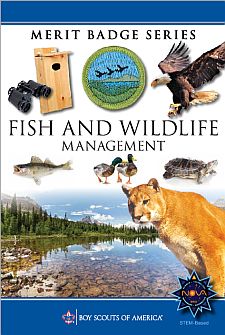- Describe the meaning and purposes of fish and wildlife conservation and management.
- List and discuss at least three major problems that continue to threaten your state's fish and wildlife resources.
- Describe some practical ways in which everyone can help with the fish and wildlife effort.
- List and describe five major fish and wildlife management practices used by managers in your state.
- Do ONE of the following:
- Construct, erect, and check regularly at least two artificial nest boxes (wood duck, bluebird, squirrel, etc.) and keep written records for one nesting season.
- Construct, erect, and check regularly bird feeders and keep written records of the kinds of birds visiting the feeders in the winter.
- Design and implement a backyard wildlife habitat improvement project and report the results.
- Design and construct a wildlife blind near a game trail, water hole, salt lick, bird feeder, or birdbath and take good photographs or make sketches from the blind of any combination of 10 wild birds, mammals, reptiles, or amphibians.
- Do ONE of the following:
- Observe and record 25 species of wildlife. Your list may include mammals, birds, reptiles, amphibians, and fish. Write down when and where each animal was seen.
- List the wildlife species in your state that are classified as endangered, threatened, exotic, game species, furbearers, or migratory game birds.
- Start a scrapbook of North American wildlife. Insert markers to divide the book into separate parts for mammals, birds, reptiles, amphibians, and fish. Collect articles on such subjects as life histories, habitat, behavior, and feeding habits on all of the five categories and place them in your notebook accordingly. Articles and pictures may be taken from newspapers or science, nature and outdoor magazines; or from other sources including the Internet (with your parent's permission). Enter at least five articles on mammals, five on birds, five on reptiles, five on amphibians, and five on fish. Put each animal in alphabetical order. Include pictures whenever possible.
- Do ONE of the following:
- Determine the age of five species of fish from scale samples or identify various age classes of one species in a lake and report the results.
- Conduct a creel census on a small lake to estimate catch per unit effort.
- Examine the stomach contents of three species of fish and record the findings. It is not necessary to catch any fish for this option. You must (may) visit a cleaning station set up for fishermen or find another, similar alternative.
- Make a freshwater aquarium. Include at least four species of native plants and four species of animal life, such as whirligig beetles, freshwater shrimp, tadpoles, water snails, and golden shiners. After 60 days or observation, discuss with your counselor the life cycles, food chains, and management needs you have recognized. After completing requirement 7d to your counselor's satisfaction, with your counselor's assistance, check local laws to determine what you should do with the specimens you have collected.
- Using resources found at the library and in periodicals, books, and the Internet (with your parent's permission), learn about three different kinds of work done by fish and wildlife managers. Find out the education and training requirements for each position.
NOTE: The last sentence of requirement 7c , which was added to the merit badge pamphlet in 2004, has read "You may visit ..." in the merit badge pamphlet, and "You must visit ..." in every edition of Boy Scout Requirements since it was added to that book in 2005.
The correct word should probably be "may", since, given the context of the entire requirement, if the Scout catches his own fish, why require him to go elsewhere to examine their stomach contents? However, until it's changed in Boy Scout Requirements, the official requirement reads "You must visit ...". We've notified the BSA merit badge development team of this issue.
BSA Advancement ID#:
51
Requirements last updated in:
2005
Pamphlet Publication Number:
33307A or 35898
Pamphlet Stock (SKU) Number:
35898
Pamphlet Revision Date:
2004
| Worksheets for use in working on these requirements: | Format | |
|---|---|---|
| Word Format | PDF Format | |
Page updated on: May 08, 2022









